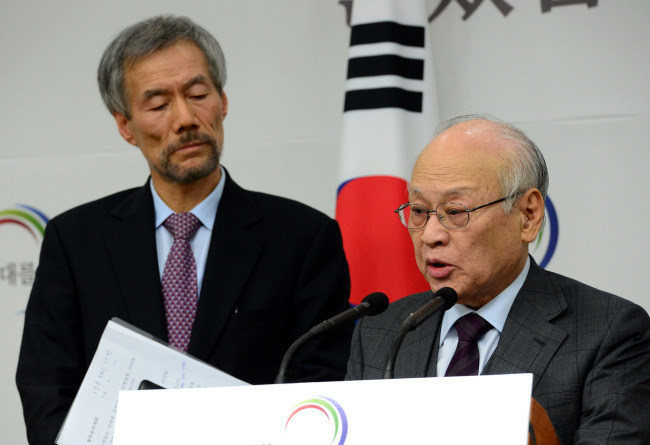
대통령직인수위원회는 내달 출범하는 `박근혜 정부'의 조직을 현행 15부2처18청에서 2개부(部) 늘린 17부3처17청으로 확정했다.
경제위기 극복을 위해 경제부총리제가 부활하고 미래창조과학부와 해양수산부가 신설됐다. 미래창조과학부에는 정보통신기술(ICT) 전담을 위한 차관제가 도입됐다.
지식경제부는 산업통상자원부로, 행정안전부는 안전행정부로 개편됐으며 특임 장관실은 폐지됐다.
김용준 인수위원장은 15일 오후 서울 삼청동 인수위 공동기자회견장에서 이 같은 내용의 정부조직개편안을 공식 발표했다.
기획재정부 장관이 겸하는 경제부총리는 경제부처 컨트롤타워 역할을 하게될 것 으로 예상된다.
보건복지부의 외청인 식품의약품안전청은 국무총리 소속의 식품의약품안전처로 이관됐다.
중소기업청의 기능이 강화돼 지식경제부가 갖고 있던 중견기업정책과 지역특화발전 기능이 중소기업청으로 옮겨갔다.
이같은 부처 신설과 업무조정에 따라 교육과학기술부는 교육부로, 국토해양부는 국토교통부로, 농림수산식품부는 농림축산부로 각각 명칭이 바뀌었다.
외교통상부도 통상교섭 기능을 산업통상자원부로 넘겨주게 됐다.
이번 미래창조과학부와 해양수산부 신설은 박근혜 대통령 당선인의 대선공약이다.
5년전 현 정부에 들어서면서 폐지된 과학기술부ㆍ해양수산부ㆍ정보통신부을 기 능을 되살리거나 강화함으로써 정부조직을 그 이전으로 환원시키는 의미가 있다.
또 경제부총리제를 부활하거나 식품의약품안전처와 안전행정부를 만든 것은 경제위기를 극복하고 국민안전을 강화하겠다는 박 당선인의 의지로 풀이된다.
`박근혜 정부'가 보수에 기반하고 있지만, 시장기능에 모든 것을 맡기지 않고 정부의 권한과 책임이 강화된 `큰 정부' 기조를 채택했다는 점도 주목된다.
<관련 영문 기사>
Park’s team unveils new government makeup
By Lee Joo-hee
President-elect Park Geun-hye plans to create a super-ministry in charge of science, information and communications as the incoming leader seeks to promote innovation-based growth.
She will also revive the post of deputy prime minister on economy and the ministry of maritime affairs and fisheries.
The overhaul plan will be submitted to the National Assembly during its extraordinary session on Feb. 24.
The science, information and technology sectors will be governed by the Future, Creation and Science Ministry (provisional name). The Science Ministry was combined with the Education Ministry by the incumbent Lee Myung-bak government five years ago.
The revived ministry will be responsible for devising long-term plans to promote research and innovation as a key aspect of Park’s vision for growth driven by creative sectors.
It is to be established in sync with Park’s vision to set up control towers to coordinate policies and reduce the divisive, exclusive, and overlapping operation among government organizations.
The Social Security Commission (provisional name) will coordinate welfare policies and administer their financing. This body will therefore work with 10 agencies including the ministries of health and welfare, strategy and finance and employment and labor.
To coordinate and supervise security affairs, the National Security Office (provisional name) will be based at Cheong Wa Dae.
The office will be in charge of adjusting policies, crisis management and preparing mid and long-term strategies on foreign affairs, defense and inter-Korean relations. The role is an integration of the tasks dealt with by Cheong Wa Dae’s office for the presidential secretary for foreign affairs and security and the national security council.
The head of the office will thus be at a ministerial level.
The Maritime Affairs Ministry, meanwhile, will also be revived, five years after it was closed down by the Lee administration.
These and other government overhaul plans were conjured up by Sungkyunkwan University professor Yoo Min-bong, head of the subcommittee for planning and coordination of state affairs. The panel is joined by Ock Dong-suk of Incheon University and professor-turned-Rep. Kang Seog-hoon of the Saenuri Party.
The routine government shakeup upon each administration change every five years has been discouraged by various pundits because of the resulting confusion, inefficiency and negative side effects -- such as government agencies devoting much time to defending their existence every five years.
Under the single-term presidency of Korea, every ministry that underwent a reshuffle usually spends one year learning their new roles, another year on developing new policies, leaving just three years to get down to business.
“It is important for the government restructuring to be perceived as a process rather than a one-time outcome for a step-by-step and detailed road map (for the future),” said Dr. Park Young-won in his report published by the National Assembly Research Service.
Park also suggested determining whether the new role should be better suited to public or nongovernment body in drawing up new functions and analyzing whether the existing problems occur due to organizational or operational error.
The last government reshuffle made in the U.S., for instance, was in 2002 when the Department of Homeland Security was established for enhanced anti-terrorism role after the Sept. 11 attacks a year before.
Japan has also maintained its structure since its 2001 central government reform.
Since 1992, Korea went through a total of eight government shakeups, with 15 cases of integration and five cases of new establishments.
The only organizations that have maintained their original names since 1948 are the Ministry of Defense and the Ministry of Justice.
Meanwhile, following the government shakeup, positions of many high-ranking officials are likely to be downsized, sources said.
Park had underscored her vision to expand the number of public servants with relevant experience to better respond to the people’s needs in the education, welfare and police sectors.
The ministries that are likely to face such restructuring in accordance with their merges include the Ministry of Strategy and Finance, the Ministry of Knowledge and Economy, the Ministry of Education, Science and Technology (for the Future Creation Science Ministry) and the Ministry of Knowledge and Economy and the Korea Communications Commission (for the ICT-related body).








![[Graphic News] More Koreans say they plan long-distance trips this year](http://res.heraldm.com/phpwas/restmb_idxmake.php?idx=644&simg=/content/image/2024/04/17/20240417050828_0.gif&u=)
![[KH Explains] Hyundai's full hybrid edge to pay off amid slow transition to pure EVs](http://res.heraldm.com/phpwas/restmb_idxmake.php?idx=644&simg=/content/image/2024/04/18/20240418050645_0.jpg&u=20240419100350)





![[From the Scene] Monks, Buddhists hail return of remains of Buddhas](http://res.heraldm.com/phpwas/restmb_idxmake.php?idx=652&simg=/content/image/2024/04/19/20240419050617_0.jpg&u=20240419175937)

![[KH Explains] Hyundai's full hybrid edge to pay off amid slow transition to pure EVs](http://res.heraldm.com/phpwas/restmb_idxmake.php?idx=652&simg=/content/image/2024/04/18/20240418050645_0.jpg&u=20240419100350)

![[Today’s K-pop] Illit drops debut single remix](http://res.heraldm.com/phpwas/restmb_idxmake.php?idx=642&simg=/content/image/2024/04/19/20240419050612_0.jpg&u=)